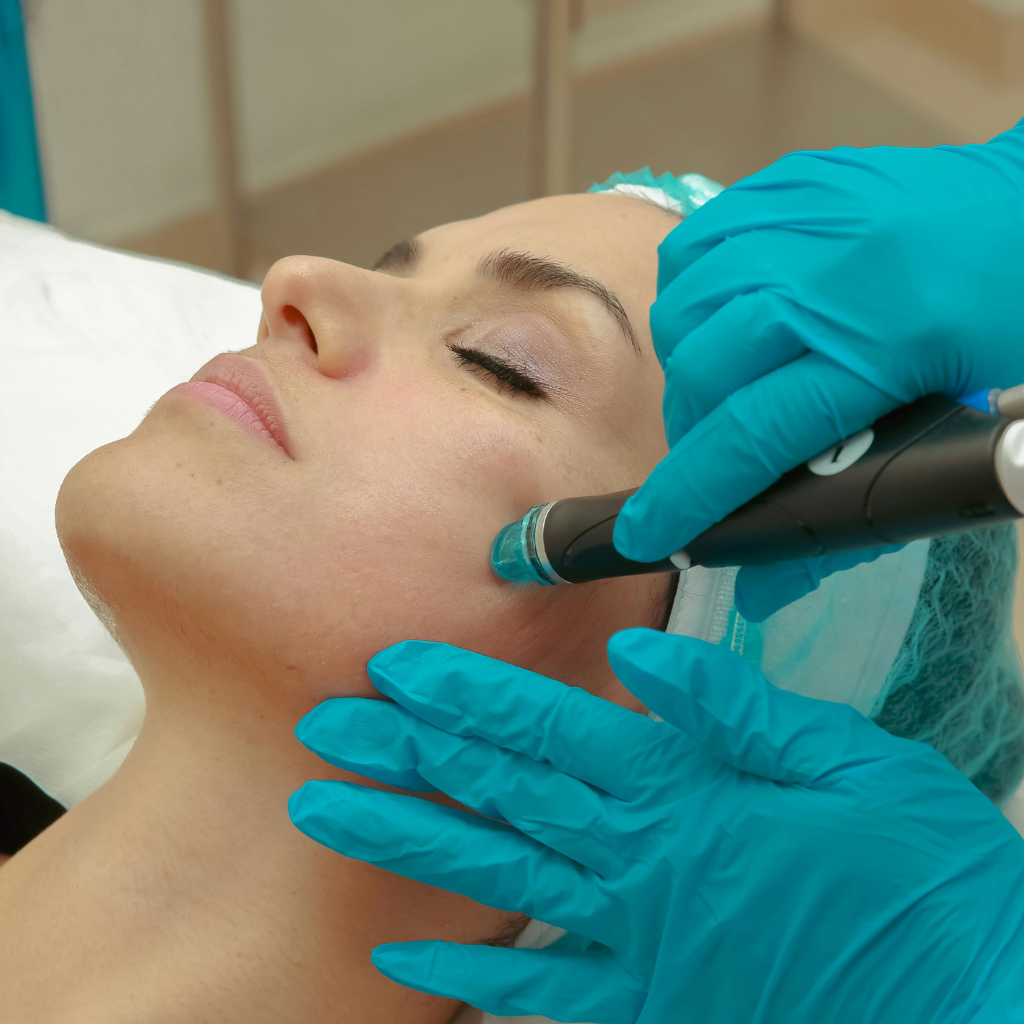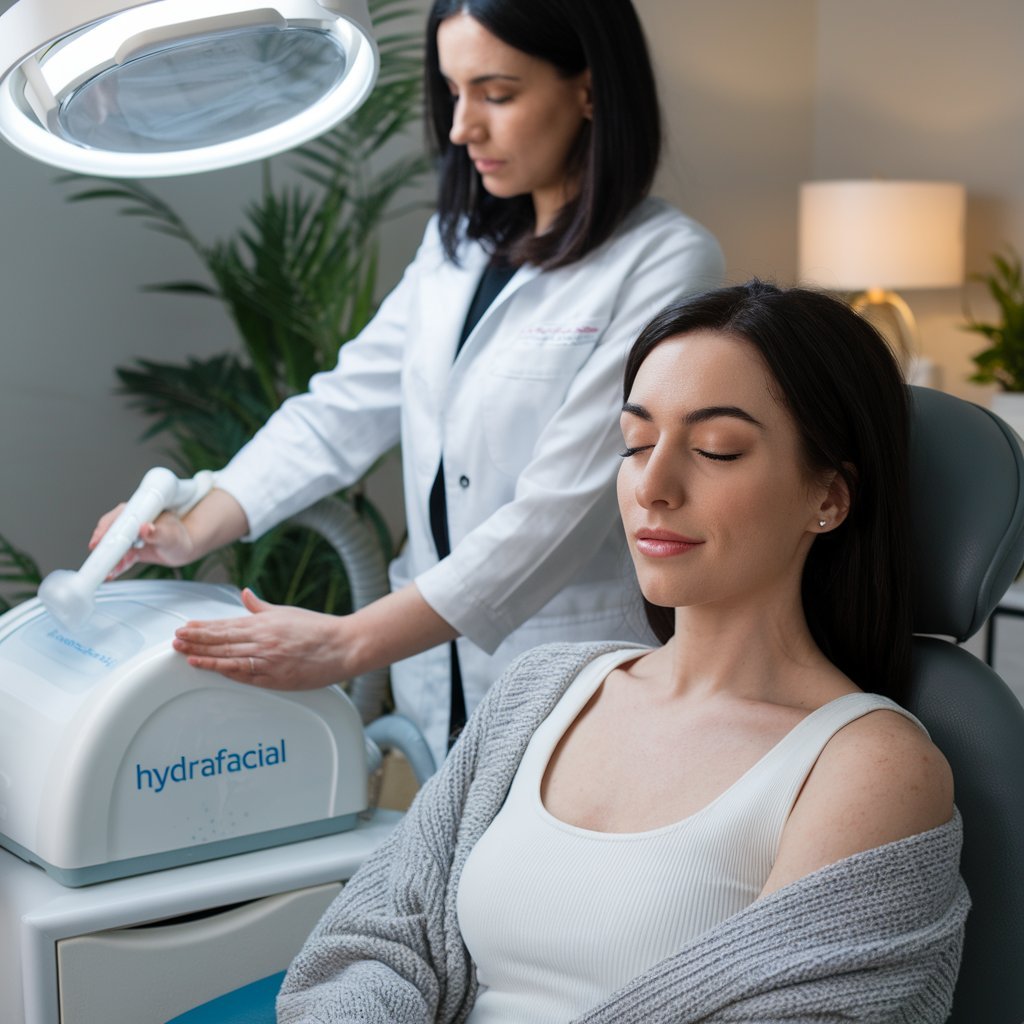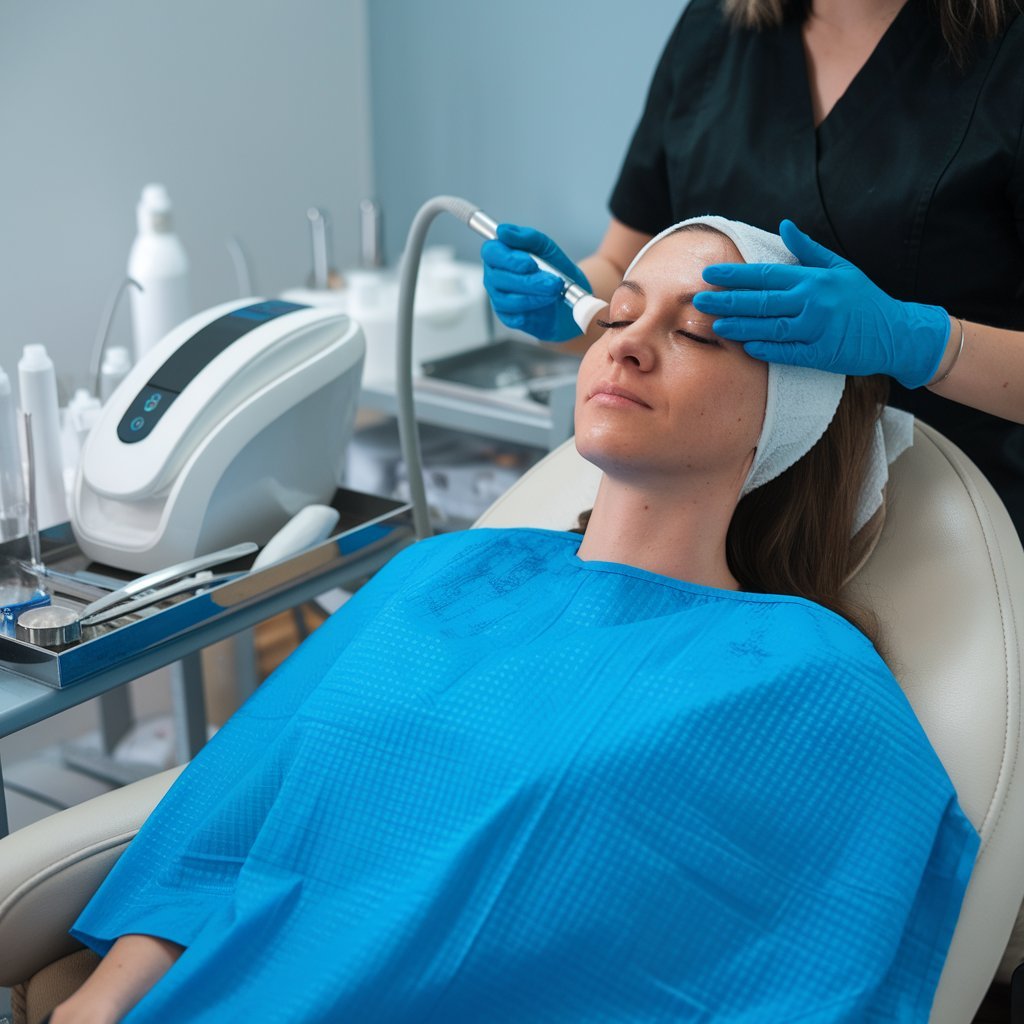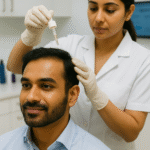How to Prepare for a Hydrafacial Treatment: First Hydrafacial & Hydration
- Home
- Skin Rejuvenation
- how to prepare for a hydrafacial

Preparing for a Hydrafacial treatment involves thorough skin cleansing and excluding retinol and exfoliants 3-5 days prior. Hydration is essential; incorporate serums and maintain skin moisture for ideal absorption. To prevent UV-related skin damage, make sure to use broad-spectrum sun protection. Arrive with a bare face, avoiding makeup or skincare products. Tailor skincare steps to individual skin needs for best outcomes. Understanding the full preparation process can maximize the benefits and enhance treatment potency.
Key Takeaways
- Discontinue retinol and exfoliating products 3-5 days before the Hydrafacial treatment.
- Arrive with a makeup-free, product-free face to ensure the best results.
- Ensure skin is well-hydrated before the appointment for better absorption.
- Use broad-spectrum sunscreen to protect skin from UV exposure before treatment.
- Get a personalized treatment plan by consulting a qualified skincare provider.
How to Prepare for Your First Hydrafacial
Prior to undergoing a Hydrafacial treatment, patients should adhere to a skincare regimen that optimizes the skin’s receptivity to the procedure.
This includes abstaining from excessive sun exposure, which can exacerbate skin sensitivity, and discontinuing the use of exfoliants or other potentially irritating skincare products.
Steps to Prepare Your Skin Before the Hydrafacial Treatment
Before undergoing a Hydrafacial treatment, it is vital to properly prepare the skin to enhance the procedure’s efficacy and guarantee excellent results.
Proper skin preparation involves several significant steps to ensure the treatment is suitable for all skin types and addresses specific skin concerns.
- Cleanse your skin: In the days leading up to your treatment, make certain you ensure a deep cleanse to get rid of impurities and traces of makeup.
- Hydrate your skin: Adequate hydration is essential for excellent results; incorporate a hydrating serum into your routine.
- Protect your skin: Utilize a broad-spectrum sunscreen to protect your skin from UV damage before your first Hydrafacial.
- Consult a treatment plan: Discuss with a skincare professional to tailor a treatment plan addressing individual skin concerns and maximize benefits.
Avoiding Sun Exposure and Other Skincare Precautions
In addition to preparing the skin through cleansing, hydration, and consultation, minimizing sun exposure is paramount to guarantee ideal conditions for a Hydrafacial treatment. Prolonged sun exposure can lead to erythema and compromised skin integrity, which may impede favourable outcomes.
Avoiding sun exposure and applying a broad-spectrum sunscreen are recommended to maintain healthy skin. These skincare precautions support skin rejuvenation and enhance the efficacy of the Hydrafacial treatment.
Patients should tailor these precautions to their skin types, ensuring they prepare for your appointment with well hydrated skin. The use of protective clothing and wide-brimmed hats further minimizes UV exposure.
What Should You Do Before the Book Your Hydrafacial Appointment?
Prior to a hydrafacial appointment, patients should cease the use of retinol and exfoliating products at least 48 hours in advance to minimize skin sensitivity.
It is advisable to arrive with a clean face, free from makeup and skincare products, to maximize treatment efficacy.
This pre-treatment protocol guarantees that the skin is in an ideal state for maximum absorption and benefit from the hydrafacial process.
How Long Before My Appointment Should I Stop Using Retinol or Exfoliants?
When considering the ideal timing to cease the use of retinol or exfoliants before a Hydrafacial appointment, many patients wonder about the recommended guidelines to guarantee their skin’s best condition.
It is generally advised to discontinue retinol and exfoliants 3-5 days prior to the treatment. This precaution helps prevent potential irritation during the hydrafacial treatment steps.
Preparing for a hydrafacial involves understanding one’s skin type and adjusting skincare routines accordingly. By following this guideline, patients can avoid exacerbating skin sensitivity and optimize the benefits of the skincare treatment.
- Discontinue retinol: 3-5 days before the appointment.
- Avoid exfoliants: 3-5 days prior to reduce irritation.
- Consider skin type: Tailor pre-treatment care to individual needs.
- Optimize results: Ascertain that the skin is calm for the hydrafacial process.
Can I Wear Makeup or Use Skincare Products Before My Hydrafacial?
As patients prepare for a Hydrafacial, it is crucial to understand the role of makeup and skincare products in the days leading up to the appointment. On the day of your appointment, avoid wearing makeup to guarantee your skin is free from potential irritants. Prior to your Hydrafacial, cease using products that might irritate your skin, such as harsh exfoliants. A treatment like Hydrafacial requires the skin to be free of impurities and dead skin cells to optimize results.
Action | Timing |
Avoid makeup | Day of appointment |
Discontinue irritants | 3 days prior |
Cleanse skin gently | Night before |
The skin needs to be in its natural state to receive the full benefits of cleansing and hydration.

What to Expect During Your Hydrafacial Appointment
During a Hydrafacial appointment, patients can anticipate a multi-step procedure utilizing a patented Vortex-Fusion delivery system to cleanse, exfoliate, and hydrate the skin effectively.
The practitioner may address specific dermal concerns by adjusting the treatment’s serums and suction intensity to guarantee ideal outcomes.
Post-procedure, patients should adhere to recommended hydration and skincare guidelines to enhance the treatment’s benefits and maintain skin health.
The Hydrafacial Procedure Explained
A Hydrafacial treatment begins by thoroughly cleansing and exfoliating the skin to clear away buildup and debris from the skin’s surface.
This initial stage of the hydrafacial procedure steps is essential for preparing the skin for subsequent treatment.
Following exfoliation, a gentle acid-based peel helps remove impurities from the pores while being kind to the skin.
The next hydrafacial procedure step involves a painless vortex extraction, using a vacuum-like device to clear congestion.
Finally, the infusion of a hydrating serum replenishes moisture and enhances rejuvenated skin.
- Cleansing and Exfoliation: Removes dead skin cells and impurities.
- Acid Peel: Loosens debris from pores.
- Vortex Extraction: Clears pores painlessly.
- Serum Infusion: Hydrates and nourishes skin.
Each step guarantees an effective facial treatment and ideal skincare benefits.
Handling Skin Concerns During the Treatment
How can patients effectively address their specific skin concerns during a Hydrafacial treatment? The procedure is designed to target and treat various dermatological issues by utilizing advanced techniques. Initially, the treatment works to remove dead skin cells, preparing the skin for extraction and impurity removal. This process aids in addressing specific skin concerns through a series of steps that hydrate the skin and maintain healthy skin integrity.
Step | Action | Purpose |
Cleansing | Remove dead skin cells | Prepare skin for extraction |
Exfoliation | Mild acid peel | Eliminate impurities |
Extraction | Vacuum suction | Remove blackheads and debris |
Hydration | Infusion of serums | Hydrate the skin |
Protection | Application of antioxidants | Maintain healthy skin |
These methods, used during the treatment, guarantee thorough skin care.
Understanding Post-Treatment Hydration and Care
After undergoing a Hydrafacial treatment, patients should anticipate a period of enhanced hydration and improved skin texture due to the infusion of nourishing serums.
This effective treatment aims to deliver thorough skin rejuvenation, resulting in glowing skin and a youthful skin appearance.
Post-treatment care is vital to guarantee that your Hydrafacial yields maximum benefits, promoting skin renewal and long-lasting improvements in skin quality.
- Hydration: Maintain ideal hydration levels to support skin recovery.
- Avoid Sun Exposure: Limit UV exposure to protect the skin’s newly refreshed state.
- Gentle Cleansing: Use mild cleansers to prevent irritation and preserve the skin barrier.
- Moisturize Regularly: Apply a suitable moisturizer to keep the skin looking supple and nourished.
Proper post-treatment care is essential for sustaining the enhancements achieved through the Hydrafacial.
What Are the Best Post-Treatment Care Tips You Should Follow?
Post-hydrafacial care is pivotal in sustaining the treatment’s beneficial effects, with emphasis on adequate hydration to support skin barrier function.
Hyaluronic acid, renowned for its hydrophilic properties, should be incorporated to enhance moisture retention and promote dermal elasticity.
Additionally, the application of broad-spectrum sunscreen is imperative to protect the rejuvenated epidermis from ultraviolet-induced damage.

Maintaining Healthy Skin with Proper Hydration
To maintain healthy skin following a Hydrafacial treatment, it is essential to prioritize proper hydration, which supports skin barrier function and optimizes cellular repair.
A well-hydrated dermis enhances the benefits of a hydrafacial treatment, improving skin texture and promoting radiant skin. The results of your hydrafacial can be optimized through consistent hydration, contributing to long-term skin health.
Patients should consider the following strategies:
- Increase daily water intake to support cellular hydration and overall skin health.
- Use a gentle, hydrating moisturizer to lock in moisture without irritating the skin.
- Avoid harsh exfoliants that can disrupt the skin barrier post-treatment.
- Incorporate hydrating serums that contain ingredients like glycerin to enhance moisture retention.
These measures guarantee that after you book your hydrafacial, your skin remains luminous and healthy.
The Role of Hyaluronic Acid in Post-Treatment Care
Hyaluronic acid plays a significant role in post-treatment care, enhancing the benefits of a hydrafacial by providing superior hydration and supporting skin repair.
A hydrafacial involves multiple steps that rejuvenate the skin, making it essential to incorporate hyaluronic acid in post-care routines. This compound aids in maintaining skin moisture levels, counteracting dehydration that may irritate the skin.
Its efficacy in reducing fine lines and improving the appearance of ageing skin makes it an indispensable element among treatments available.
Post-hydrafacial, applying a hyaluronic acid serum is a vital step to optimize results and prepare the skin for a hydrafacial in future sessions. It assists in prolonging the effects of the treatment, ensuring a refreshed, youthful appearance of your skin.
Using a Broad-Spectrum Sunscreen to Protect and Hydrate Your Skin
While the skin is in a vulnerable state following a hydrafacial, applying a broad-spectrum sunscreen is essential to safeguard it from harmful UV radiation.
This post-treatment care step is critical in maintaining the skin’s glow and preventing potential damage. Broad-spectrum sunscreens protect against both UVA and UVB rays, which is important after procedures like chemical peels and laser treatments.
To maximize skin protection, consider the following guidelines:
- Select an SPF of 30 or higher to guarantee adequate coverage.
- Reapply every two hours, especially if outdoors or after swimming.
- Choose physical sunscreens with zinc oxide or titanium dioxide for sensitive skin.
- Avoid sun exposure during peak hours to further protect the skin.
Take the first step towards radiant skin and contact your dermatologist today to schedule your hydrafacial.
How Were the Results Used and What Followed?
Patients can typically observe the initial effects of a Hydrafacial treatment within a few days, characterized by enhanced skin luminosity and reduced pore size.
For ideal hydration maintenance, clinical guidance suggests a treatment regimen every four to six weeks, tailored to individual skin needs.
Indicators of a favourable response include improved skin texture and elasticity, signifying effective dermal hydration. When comparing Hydrafacial and Microdermabrasion treatments, understanding these outcomes helps in selecting the most suitable option based on skin type and desired results.
How soon can I expect to see results from my Hydrafacial?
Results from a Hydrafacial treatment can become apparent almost immediately, as the procedure is designed to cleanse, exfoliate, and hydrate the skin deeply.
This innovative facial treatment utilizes a patented Vortex-Fusion delivery system, facilitating the removal of impurities while simultaneously infusing the skin with essential serums.
Patients may notice:
- Enhanced skin texture: The exfoliation process reduces roughness, enhancing smoothness.
- Improved skin tone: The infusion of serums can contribute to a more even complexion.
- Increased hydration: Immediate hydration effects lead to plumper, more supple skin.
- Diminished appearance of fine lines: The hydrating properties may soften fine lines and wrinkles.
These outcomes are typically visible immediately post-treatment, although individual results may vary based on skin type and specific conditions.
How Often Should I Get a Hydrafacial for Optimal Hydration?
Determining the frequency of Hydrafacial treatments is integral to sustaining ideal skin hydration and maintaining the benefits achieved immediately post-procedure. In medical practice, the consensus suggests a regimen of facials every four to six weeks to optimize hydration. This frequency facilitates consistent exfoliation, extraction, and hydration, which is essential for the homeostasis of the cutaneous barrier.
Frequency (Weeks) | Expected Benefit |
4 | Enhanced hydration and glow |
5 | Sustained moisture and texture |
6 | Maintenance of dermal homeostasis |
Patients must consider individual dermal needs and lifestyle factors and consult with dermatological experts to tailor a regimen. Each session rejuvenates the epidermis, prolonging the efficacy of the preceding treatment and thereby enhancing cellular turnover and nutrient absorption for a luminous complexion.
What Signs Indicate My Skin is Responding Well to the Treatment?
A key indicator of positive skin response following a Hydrafacial treatment is the noticeable improvement in skin texture and radiance within the first few days post-procedure.
This enhanced luminosity results from the effective exfoliation and hydration processes inherent in the treatment.
Additional signs of a favourable response include:
- Reduced pore size: As impurities are extracted, pores appear smaller and less conspicuous.
- Diminished fine lines: The infusion of serums may lead to a temporary reduction in fine lines and wrinkles.
- Improved skin tone: Evenness in complexion often indicates the successful removal of dead skin cells.
- Increased hydration: A plump, dewy appearance suggests ideal moisture retention.
Patients should monitor these indicators to evaluate treatment efficacy and guide subsequent skincare routines.
Conclusion
To summarize, preparing for a Hydrafacial involves proper skincare and hydration to maximize treatment efficacy. Prior to the appointment, patients should avoid excessive sun exposure and discontinue the use of retinoids. During the procedure, expect thorough cleansing, exfoliation, and hydration. Post-treatment, maintaining a gentle skincare regimen and using sunscreen are critical to preserving results. Patients often experience improved skin texture and hydration, with follow-up sessions recommended to sustain and enhance benefits. Compliance with professional guidance guarantees ideal outcomes.

Highly skilled cosmetologist at Tune Clinical Aesthetics, specializing in advanced skin and hair treatments.





